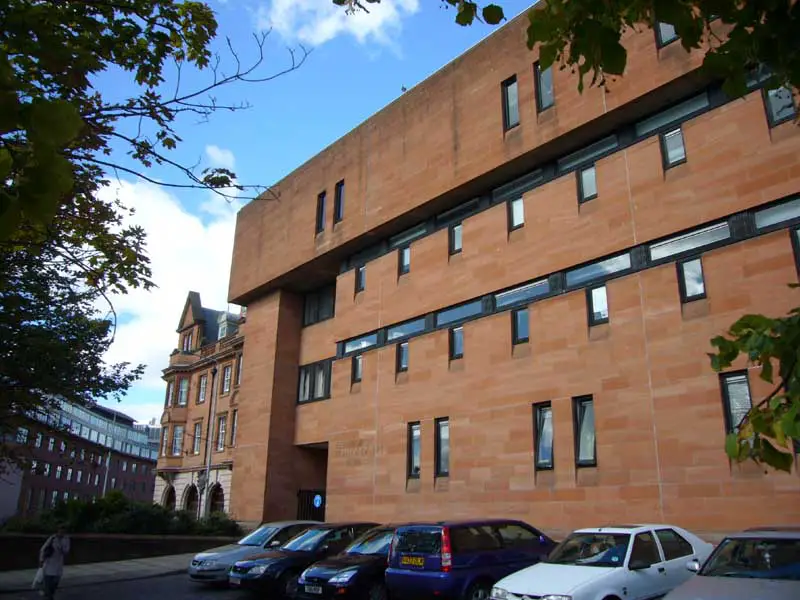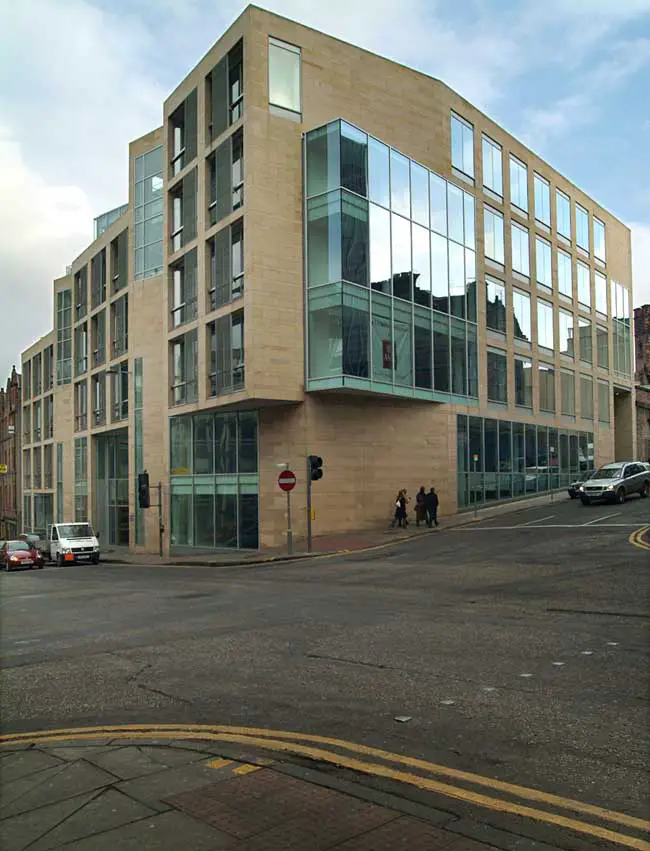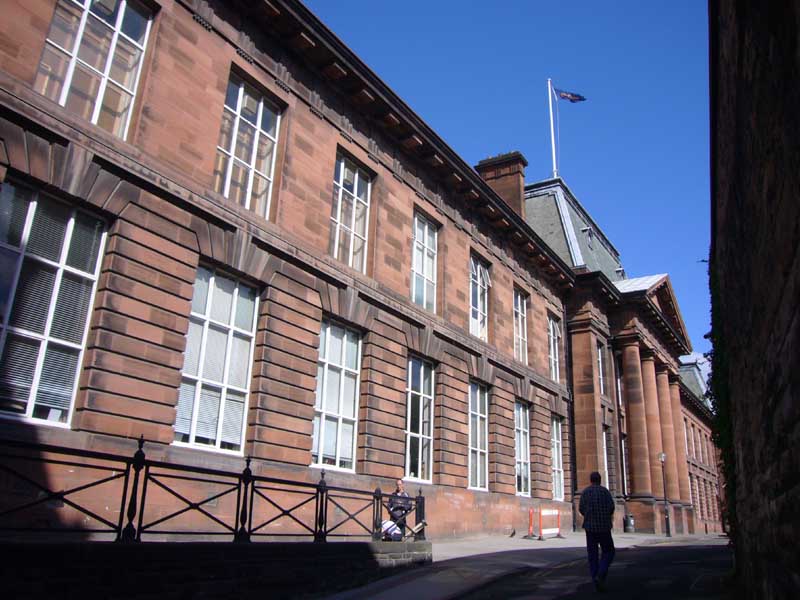Edinburgh College of Art (ECA) is an art, design, creative and performing arts school in Edinburgh, the oldest and largest in Scotland, providing higher education in art and design, architecture, history of art and music disciplines for over two thousand University of Edinburgh students. ECA has an international reputation as one of the most successful art colleges in Europe; its stated mission is to promote critical inquiry through scholarly research, learning, teaching and education in creative practice. Edinburgh College of Art is a School in the College of Humanities and Social Science, University of Edinburgh. ECA is mainly located in the Old Town of Edinburgh, overlooking the Grassmarket; the Lauriston Place campus is not far from the University of Edinburgh's George Square campus. It was ranked 1st in Art and Design in the UK in the Complete University Guide 2012.
The college was founded in 1760, and gained its present name and site in 1907. Formerly associated with Heriot-Watt University, its degrees have been issued by the University of Edinburgh since 2004. The College formally merged with the University on 1 August 2011, combining with the School of Arts, Culture and Environment and continues to exist with the name Edinburgh College of Art as an enlarged school in the College of Humanities and Social Sciences. As a result, the new Edinburgh College of Art comprises not only Art, Design, Architecture and Landscape Architecture, but also History of Art and Music. In September 2011 Professor Chris Breward became Principal of Edinburgh College of Art (ECA) and Vice Principal Creative Industries & Performing Arts of the University of Edinburgh.
History
Edinburgh College of Art Fashion Show 2013 - Tickets are now on sale for the 2014 Edinburgh College of Art Fashion Show, one of Scotland's biggest style events. Watch the highlights from last year's show, ...
Edinburgh College of Art can trace its history back to 1760, when the Trustees Drawing Academy of Edinburgh was established by the Board of Trustees for Fisheries, Manufactures and Improvements in Scotland. This board had been set up by Act of Parliament in 1727 to "encourage and promote the fisheries or such other manufactures and improvements in Scotland as may most conduce to the general good of the United Kingdom". The aim of the academy was to train designers for the manufacturing industries. Drawing and the design of patterns for the textile industries were taught at the Academy's rooms at Picardy Place.
The Board was responsible for the construction of the Royal Institution (named for the Royal Institution for the Encouragement of the Fine Arts in Scotland), now the Royal Scottish Academy building, on The Mound and also commissioned the Scottish National Portrait Gallery on Queen Street. From 1826, classes were held at the Royal Institution building. The Master of the School was always a fine artist, the first being French painter William Delacour. Subsequent masters included Alexander Runciman and David Allan. The Academy's focus gradually shifted from applied arts to encompass fine art, and the school gained a reputation for excellence in both painting and design. Scottish artists who were trained at the Academy include John Brown, Alexander Nasmyth and Andrew Wilson.
In 1858, the Academy was affiliated to the Science and Art Department in London, known as the "South Kensington system", under which it became the Government School of Art for the city of Edinburgh. A School of Applied Art was also established under this system. The Drawing School became part of a system of schools managed on similar lines, and distinctive teaching practices were lost. In 1903 it amalgamated with the School of Applied Art. In 1907, the Scottish Education Department took over responsibility for the school, and it became Edinburgh College of Art.
The College was officially recognised by the Scottish Government as a Small Specialist Institution for the teaching of art, design and architecture prior to the merger with University of Edinburgh in 2011. From 1968 to 2004, it was associated with Heriot-Watt University for degree awarding purposes. Today's students graduate from the College with degrees awarded by the University of Edinburgh as prior to the merger in 2011, the two institutions were partners in an academic federation.
In 2005, the College joined with Edinburgh Napier University to launch the Screen Academy Scotland, a new centre of excellence in film learning and education.
The College Buildings

With the creation of Edinburgh College of Art in 1907, the institution moved to new premises on Lady Lawson Street. Formerly a cattle market, the site lies above the Grassmarket and opposite Edinburgh Castle. The red sandstone main building was designed in the Beaux-Arts style by John More Dick Peddie and George Washington Browne, and was completed in 1909. The main building was listed Category A in 1970. Inside, the Sculpture Court displays casts of the Elgin Marbles and other antique statuary, alongside changing displays of contemporary student's work.
The Architecture Building was added to the east end of the college in 1961, designed by architect Ralph Cowan, who was a Professor of Architecture at the college. In 1977 the campus was completed in its present form with the addition of the Hunter Building. This L-shaped red sandstone block encloses the college courtyard, and fronts Lauriston Place to the south. In the 1990s the college took over a separate group of buildings in the Grassmarket, for use as a library and teaching space, and also took over the former Salvation Army building on West Port. These buildings in the Grassmarket and West Port were disposed of after the College took over Evolution House.
The nine-storey Evolution House on West Port by Reiach and Hall Architects was completed 2003, adjacent to the main College building. Built as speculative offices, it now houses the art and design library, as well as providing design studios and office facilities. The College is now concentrated on the Lauriston Place site, and the Grassmarket (First Year studies) and former Salvation Army buildings (Animation and Postgraduate Tapestry studios) have been sold.
As a result of the merger with the University of Edinburgh in August 2011 the new enlarged ECA includes Minto House, Chambers Street (History of Art and Architecture) and Alison House in Nicolson Square (Music).
Notable alumni and academics

See also Category:Alumni of the Edinburgh College of Art
Architects
- Sir Nicholas Grimshaw (born 1939), architect of the Eden Project, president of the Royal Academy since 2004
- Sir Robert Matthew (1906â€"1975), designed the Royal Commonwealth Pool and founded RMJM
- Patrick Nuttgens (1930â€"2004), academic and writer on architecture
- Sir Basil Spence (1907â€"1976), architect of Coventry Cathedral
- Sir William Kininmonth (1904â€"1988), architect of Adam House and Pollock Halls, both in Edinburgh
- Sir James Dunbar-Nasmith (born 1927), conservation architect and head of ECA's Department of Architecture 1978â€"1988
- Rab and Denise Bennetts, founders of Bennetts Associates
Artists
- Wilhelmina Barns-Graham, artist
- Dame Elizabeth Blackadder, artist
- Paul Carter, artist
- Stanley Cursiter, artist
- Alan Davie, artist
- William Geissler, artist
- William George Gillies, artist
- Sir James Gunn, artist
- William McLaren, artist
- Wendy McMurdo, artist
- David Michie, artist
- John Maxwell, artist
- Katie Paterson, artist and Honorary Fellow of the University of Edinburgh (2013)
- Sir Robin Philipson, artist
- John Platt, artist
- Nina Pope and Karen Guthrie, aka Somewhere
- Barbara Rae, painter and printmaker
- Anne Redpath, artist
- Patrick Reyntiens, artist
- Paul Rooney, artist
- Adam Bruce Thomson, artist
- Alan Sutherland, artist
- Richard Wright, artist, winner of the 2009 Turner Prize
Painters
- John Bellany, painter
- William Crozier, painter
- Victorine Foot, painter
- Molly Garnier, painter
- William Gear, painter
- Nicola Green, painter
- Callum Innes, painter and Turner Prize nominee
- David McClure, painter
- Sir William MacTaggart, painter
- Emily Murray Paterson, painter
- Samuel Robin Spark, painter
Sculptors
- Alexander Carrick, sculptor and academic
- Christopher Hall, sculptor
- Pilkington Jackson, sculptor of the iconic Robert the Bruce statue at Bannockburn, and the college war memorial (1922)
- Hew Lorimer, sculptor
- James Pittendrigh MacGillivray, sculptor
- Sir Eduardo Paolozzi, sculptor and artist
Musicians
- Roy Williamson, member of The Corries, and author of Flower of Scotland
- The Rezillos, 1970s new wave band, featuring Jo Callis who went on to The Human League
- Jamie Muir, percussionist with Music Improvisation Company, King Crimson, Giles, Muir, Cunningham
- The Magnificents, Scottish rock band
- Sandy Brown, Scottish Jazz clarinettist
- Al Fairweather, Scottish Jazz trumpeter
- Futuristic Retro Champions, Scottish ElectroPop band
- Django Django, band
Writers
- John Arden, playwright
- Alan Bold, poet
- Ruthven Todd, poet, novelist
Other
- Adam Robson, rugby player, former head of the Scottish Rugby Union
- Aileen Paterson writer and illustrator of children's books.
- David Shaw Nicholls, designer & architect
- Kerry Anne Mullaney, film director
- Ryan McHenry, film director
- Shashi Caan, Interior Architect/Designer and President of The International Federation of Interior Architects/Designers(IFI)
- Holly Fulton, fashion designer
See also

- List of further and higher education colleges in Scotland
- University of Edinburgh
References

- Notes on the Early History of the Royal Scottish Academy, George Harvey, (Edmonston & Douglas, 1873)
- Archives of Scottish Higher Education
See also, Scott Lawrie - The History of Edinburgh College of Art 1906-1969, MPhil Thesis, 1995. Copies held in ECA library and Heriot-Watt University Library.
- ^ New Chancellor elected | Archive news |
- ^ Professor Chris Breward | Vice Principals and Senior Management |
- ^ a b http://www.docs.csg.ed.ac.uk/HumanResources/StaffNumbers.htm
- ^ http://www.docs.sasg.ed.ac.uk/gasp/factsheet/StudentFactsheet310712.pdf
- ^ Edinburgh College of Art | Edinburgh College of Art
- ^ Colleges and Schools | Schools and departments
- ^ "Introduction | ECA Merger | Edinburgh College of Art". Ed.ac.uk. Retrieved 14 October 2011.Â
- ^ "ECA; Edinburgh College of Art". Ed.ac.uk. Retrieved 26 April 2012.Â
- ^ "Professor Chris Breward; ECA; Edinburgh University". Ed.ac.uk. Retrieved 26 April 2012.Â
- ^ "history of the college". eca. Retrieved 14 October 2011.Â
- ^ "the college and the university". eca. 1 August 2011. Retrieved 14 October 2011.Â
- ^ Edinburgh Cast Collection. Edinburgh College of Art. Retrieved on 21 June 2010.
- ^ Pithers, Ellie (15 February 2014). "The world of fashion designer Holly Fulton". Daily Telegraph. Retrieved 7 April 2014.Â
External links
- Edinburgh College of Art home page
- Possible merger: University of Edinburgh with Edinburgh College of Art

Post a Comment